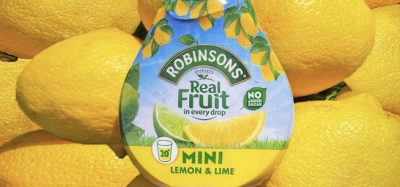Novel processed food packaging challenges
- Like
- Digg
- Del
- Tumblr
- VKontakte
- Buffer
- Love This
- Odnoklassniki
- Meneame
- Blogger
- Amazon
- Yahoo Mail
- Gmail
- AOL
- Newsvine
- HackerNews
- Evernote
- MySpace
- Mail.ru
- Viadeo
- Line
- Comments
- Yummly
- SMS
- Viber
- Telegram
- Subscribe
- Skype
- Facebook Messenger
- Kakao
- LiveJournal
- Yammer
- Edgar
- Fintel
- Mix
- Instapaper
- Copy Link
Posted: 4 November 2010 | Nathalie Gontard, Valérie Guillard, Miguel Mauricio Iglesias, Stéphane Peyron & Sana Raouche Joint Research Unit Agropolymers Engineering and Emerging Technologies – UMR 1208 Montpellier SupAgro, INRA and Salvatore Iannace, Institute of Composite and Biomedical Materials, National Research Council of Italy and Giuseppe Mensitieri & Ernesto Di Maio, Dept. of Materials and Production Engineering, University of Naples Federico II | No comments yet
In the last few years, the fast development of novel processing methods for food preservation to improve safety, quality and shelf life of packaged foods gave place to important gaps of knowledge that must be filled in the area of suitable packaging materials. In particular, in the European Project NovelQ (FP6-CT-2006-015710), the effect of novel processing technologies, such High Pressure (HP) as well as microwave (MW) heating on the performances and structural integrity of several types of packaging materials has been investigated along with issues related to food/packaging interactions. HP treatment is steadily gaining as a food preservation method that maintains the natural sensory and nutritional attributes of food, extending shelf life with minimal quality loss. It consists of applying high pressure (typically in the 300-800 MPa range over a period of several minutes) to packaged foodstuff to greatly reduce the number of microorganisms and also to deactivate enzymes by mechanical action. HP pasteurisation is conducted at 25 – 40°C while HP sterilisation is conducted at 90 – 110°C. We discuss here some relevant issues addressed in the NovelQ project related to the effect of HP treatments on packaging materials in terms of mechanical resistance of packaging structures, of the possible reduction of their functional properties (e.g. barrier properties) and of possible migration and scalping phenomena of small molecules in conventional plastic, novel biodegradable and nano – composite packaging materials. Moreover, in this contribution we also report on packaging/ food interaction during MW heating of packaged foodstuff…
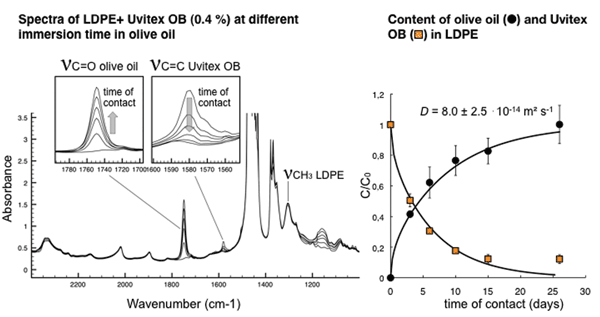

Figure 5 Example of the use of non-destructive FT-IR based methodology to study simultaneous olive oil and Uvitex OB (additive) migration in LDPE (adapted from Mauricio-Iglesias et al40
In the last few years, the fast development of novel processing methods for food preservation to improve safety, quality and shelf life of packaged foods gave place to important gaps of knowledge that must be filled in the area of suitable packaging materials. In particular, in the European Project NovelQ (FP6-CT-2006-015710), the effect of novel processing technologies, such High Pressure (HP) as well as microwave (MW) heating on the performances and structural integrity of several types of packaging materials has been investigated along with issues related to food/packaging interactions. HP treatment is steadily gaining as a food preservation method that maintains the natural sensory and nutritional attributes of food, extending shelf life with minimal quality loss. It consists of applying high pressure (typically in the 300-800 MPa range over a period of several minutes) to packaged foodstuff to greatly reduce the number of microorganisms and also to deactivate enzymes by mechanical action. HP pasteurisation is conducted at 25 – 40°C while HP sterilisation is conducted at 90 – 110°C. We discuss here some relevant issues addressed in the NovelQ project related to the effect of HP treatments on packaging materials in terms of mechanical resistance of packaging structures, of the possible reduction of their functional properties (e.g. barrier properties) and of possible migration and scalping phenomena of small molecules in conventional plastic, novel biodegradable and nano – composite packaging materials. Moreover, in this contribution we also report on packaging/ food interaction during MW heating of packaged foodstuff.
Suitability of commercial packaging materials for HP treatments
Packaging materials for HP treatments have to be flexible enough to withstand the compression forces while maintaining physical integrity without losing the properties which guarantee the adequate protection of packaged food1,2. In fact, HP treatment can promote changes in crystallinity, density and orientation of plastic packaging materials that could affect, in turn, mechanical and mass-transfer (vapour and gas barrier, migration/scalping) properties of the package in a significant extent. Moreover, interfacial stresses arising between the different elements of multilayer structures as a result of the high pressure, could bring about delamination and extensive detachment of the layers. In the course of the NovelQ project, a systematic analysis has been performed on the behaviour of flexible single materials and multilayer commercial plastic structures (Table 1), used to package selected foodstuff (i.e. tap water, carrot juice, carrot puree and solid sliced carrots) to be HP treated.
Table 1:
| Material | Abbreviated identification |
| Single material films | |
| Linear Low Density Polyethylene | LLDPE |
| Cast Polypropylene | PP cast |
| Multilayer laminated films | |
| Bioriented Polyetheyleneterephthalate/Linear Low Density Polyethylene | PET-LLDPE |
| Bioriented Polyetheyleneterephthalate/cast polypropylene | PET-PPcast |
| Metallized Bioriented PET/ Linear Low Density Polyethylene | PETmet-LLDPE |
| Bioriented Polyetheyleneterephthalate/Polyamide/Aluminum foil/ Linear Low Density Polyethylene | PET/PA/Al/LLDPE |
| Cast Polypropylene/Bioriented Polyethyleneterephthalate/Polyvinylidene chloride-coated | PP cast/PET/PVDC coated |
| Cast Polyamide/Cast Polypropylene | PA cast/PP cast |
| Cast Polyamide/ink/Cast Polypropylene | PA cast/Ink/PP cast |
| Multilayer coextruded films | |
| Bioriented Polyamide/Cast Polypropylene | OPA/PP cast |
| Polypropylene/ Polyethylenevinylalcohol/Polypropylene | PP/EVOH/PP |
| Polypropylene/Polyamide/Polypropylene | PP/PA/PP |
Tests performed on films of LLDPE and of PP confirmed that these materials are capable of withstanding the HP treatment conditions, both for pasteurisation and sterilisation, without displaying significant changes or deterioration of barrier, mechanical and morphological properties, as also reported in the recent literature3. It is worth noting that LLDPE can be submitted to treatments at temperatures as high as 110°C without occurrence of melting, since HP conditions promote an increase of melting temperature. Referring to laminated structures, the PA cast / PP cast bilayer films were found to be the most suitable for HP pasteurisation and sterilisation up to 700-800 MPa (see Figure 1), although results were to some degree dependent on the adopted lamination adhesive. Slightly worse results were obtained with OPA/PP cast films, while multilayer structures made of PET/PP were found unsuitable for HP sterilisation due to delamination phenomena (Figure 1, left side). However, we cannot exclude that better results could be obtained with PET/PP structures made of films processed in different conditions as compared to the materials we used (e.g. different degree of orientation or different heat setting procedures of PET films). In general, the multilayer structures withstanding processing without delaminating did not display significant changes of mechanical and functional properties as a consequence of treatment. Moreover, our results confirmed that films including aluminium foil or metallised layers are unsuitable for HP sterilisation, as already indicated in some literature reports1,2,4 due to extensive delamination phenomena.
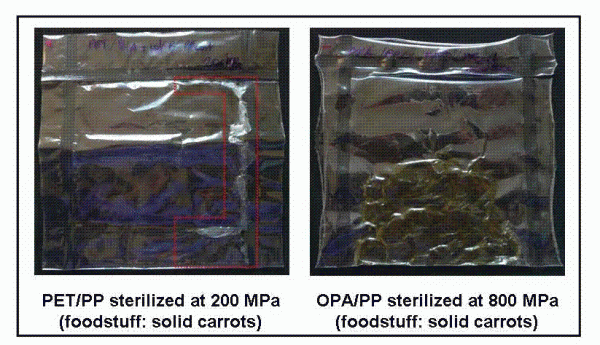

Figure 1 Photographs bilayer structures used to package solid carrots, after HP sterilisation. The delaminations areas in the case of PET/PP cast films (left side) highlighted with dashed red line
Finally, tested coextruded structures did not perform as well as best performing laminated structures at the highest pressure / temperature conditions. The results reported above are in agreement with recent results reported in the literature5. Experimental results on delamination of multilayer films have been rationalised in terms of a finite element (FEM) analysis of the process of HP treatment of pouches made by using multilayer films containing tap water. The delamination occurrence was attributed to the development of interlaminar normal and shear stresses. To summarise the findings of FEM simulations for the case of bi-layer films, it can be stated that an ‘heuristic’ measure of the goodness of the coupling between layers is the percentage difference between the Young modulus of one of the films and the overall modulus of the bi-layer structure: the lower this difference, the lower the likelihood of interfacial failure. In practical terms, in the case of examined bilayer structures including PP cast film (i.e. PA cast/PP cast; OPA/PP cast and PET/PP cast) this rough measure would predict the ‘best coupling’ in the case of PA cast/PP cast bi-layer films. This is exactly what emerges from the experimental evidences.
Biodegradable packaging materials for high pressure treatments
Suitability of two classes of biodegradable polymers for HP treatments were investigated analysing: i) commercial coextruded multilayer PLA structures and ii) novel laminates based on thermoplasticised zein. PLA oriented multilayer films, made of two top sealable amorphous PLA layers and of a core of partially crystalline PLA (Treofan 121 by Biophan, 44 μm thick), has been used to prepare pouches containing tap water or solid carrots. The pouches have been treated to HP pasteurisation and to sterilisation. While pasteurisation did not promote relevant variations of the barrier properties of PLA, HP sterilisation treatments promoted relevant changes in crystallinity which was accompanied by brittlening of the material. Figure 2 shows the micro-Raman profiles of the PLA films and a picture of the PLA pouches after the HP sterilisation. The profile analysis in Figure 2 shows that the crystalline amount after the HP treatment (circles) is rather uniform along the thickness, indicating that the crystallinity in the external layers increased as a consequence of the HP treatments. Lamination of thermoplastic zein proteins (TPZ) with hydrophobic layers of poly-ε-caprolactone (PCL) were also developed to prepare biodegradable flexible packaging materials with controlled barrier and mechanical properties suitable for high pressure pasteurisation treatments. Zein, the prolamine of corn, is of industrial interest mainly for its unique hydrophobicity and barrier to oxygen. When denaturated by applying a suitable plasticiser in combination with heat and shear, zein can be thermoplasticised6, in a way similar to thermoplastic starch7, and processed by using extrusion blowing technologies8 to prepare single layer or multilayer films. Figure 3 (right hand side) compares oxygen permeabilities of pure zein, pure PCL, multilayer PCL/zein structures and TPZ/PCL (40:60) blend: a tailoring of oxygen permeability can be obtained by a proper selection of PCL and zein structures. HP pasteurisation performed on carrot juice and solid carrots packaged with multilayer TPZ-PCL structures revealed the compatibility of such structures with HP treatments at low temperatures (Figure 3, left). In particular, HP treatment up to 700 MPa did not promote detectable changes of mechanical properties as well as oxygen and water vapour barrier properties.
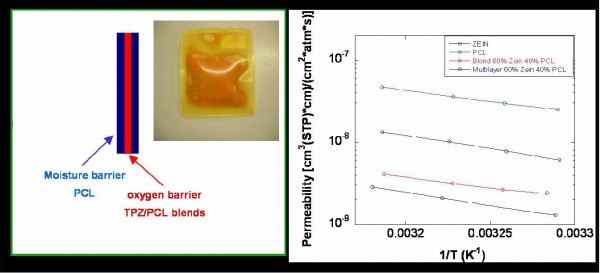

Figure 3 Left: schematic view of the multilayer novel structures based on PCL and a blend of thermoplastic zein with PCL. The photograph shows a pouch containing carrot puree after HP pasteurisation at 700 MPa. Right: oxygen permeabilities of PCL, zein and PCL/zein multilayer and blend films
These laminated TPZ/PCL structures were unsuitable for HP sterilisation due to the low glass transition temperatures of the TPZ phase (~50°C) and the low melting temperature of the PCL phase (~60°C). However, we have developed TPZ that incorporates nanolayers of silicates (nanoclay) that results in bionanocomposite materials with improved thermo-mechanical properties (increase of glass transition temperature by ~20°C), paving the way to a possible use for HP treatments at temperatures higher than those employed for HP pasteurisation.
Migration and scalping phenomena in light of food safety
Novel food processing methods, such as high pressure or microwaves, imply that both packaging and foodstuff undergo the stabilisation treatment. During such treatment, the packaging material is involved and exposed to different processing conditions which may alter its structure and consequently its mechanical and mass transfer (barrier and migration) properties. For instance, processing conditions, such as time/temperature couple undergone during conventional or microwave heating, are known to accelerate mass transfer from packaging materials into food. Numerous publications could be thus found on the effect of temperature on overall and specific migration from plastics materials into food during microwave heating9-33. Most of the authors conclude the importance of the high level of temperature that could be reached (specially in the case of susceptor technology) and its heterogeneity in the material13,30,31. Contrary to microwave heating, substantial knowledge was still required about the specific effect of pressure on food/packaging interactions at the beginning of the NovelQ project. As shown in Figure 4, only four studies dealing with this subject were found in literature: two dealing with the global migration34,35 and two others with the specific migration of one antioxidant, Irganox 107636, and a pressuretransmitting fluid, 1,2 propanediol36,37. All these studies were performed on synthetic plastic materials and nothing was known about the expected behaviour of biodegradable materials and ‘active’ biodegradable materials during and after HPT.
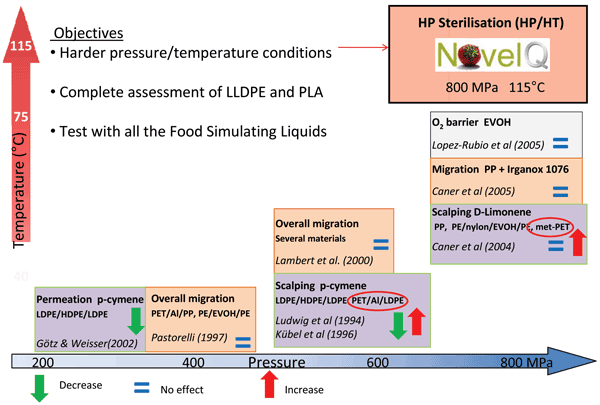

Figure 4 Overview at the starting up of NovelQ project of the available existing studies concerning impact of high pressure processing on food packaging system and synthetic presentation of the objectives of the project to go beyond the state-of-the-art (from Guillard V, Mauricio-Iglesias M, Gontard N. (in press) Crit Rev Food Sci Nutr)
It appeared thus crucial at the beginning of the NovelQ project to (1) understand and clarify the effect of high pressure treatment (especially harder pressure and temperature condition) on the food/packaging interactions of conventional synthetic material but also of biodegradable materials (Figure 4) and (2) to assess the effect of temperature heterogeneities during microwave treatment of a packed fatty food on the migration of an plastic additive.
Effect of high pressure treatment on food packaging interactions
Three materials were studied, namely linear low density polyethylene (LLDPE), polylactide (PLA) and a wheat gluten/montmorillonite (WG/MMT) nanocomposite. Food/packaging interactions were studied after two HP/T treatments intended to perform a pasteurisation (800 MPa, five minutes, 40°C) and a sterilisation (800 MPa, five minutes, 115°C) treatment, as well as subsequent storage for 10 days. Specific migration of an additive (Uvitex OB) was assessed for LLDPE and PLA, whereas other adapted tests were carried out for WG/MMT, i.e. overall migration, protein migration and nanoparticles migration. HP/T treatments did not significantly modify the migration or scalping in the conditions studied but for the release of nanoparticles from WG38,39. Furthermore, the increase in the melting point of LLDPE allowed the sterilisation of LLDPE whereas it melted when submitted to a conventional thermal sterilisation. To date the most frequently used methods in migration assessment are based in expensive and time consuming methods based on destruction and quantification. To make easier packaging testing, modelling has recently been approved as a method for migration assessment (directive 2002/72/CE). However, the parameters needed, i.e. diffusivity (D) and the partition coefficient (K) are seldom available. The use of FTIR and Raman spectroscopy to assess migration behaviour and, more importantly, to determine the diffusivity of an additive in LDPE was successfully carried out allowing a complete characterisation of mass transfer40 (Figure 5).


Figure 5 Example of the use of non-destructive FT-IR based methodology to study simultaneous olive oil and Uvitex OB (additive) migration in LDPE (adapted from Mauricio-Iglesias et al40
In the framework of the NovelQ EU project, the French JRU IATE demonstrated that antimicrobial bio-sourced packaging materials may contribute to combine environmental protection and food quality improvement. PLA-based materials containing AITC previously encapsulated in cyclodextrins was demonstrated to be an efficient optimised antimicrobial system for inhibiting B. cinerea growth during at least 10 days at 22°C. Moreover, combining mild HP treatment (around 300 MPa) and use of active film proved to be more efficient for inhibiting B. cinerea growth than either a HP pasteurisation-like treatment (800 MPa) or antimicrobial packaging used alone, even though the quantity of active compound released from the film was lower than the minimal quantity required to obtain inhibition at atmospheric pressure. This combined effect between pressure and antimicrobial agent can be used to reduce the quantity of active agent used in antimicrobial film and/or to reduce the intensity of the HP treatment (Table 2)41.
| 0.1 MPa | 300 MPa | 600 MPa | 800 MPa | |
| Control | + | + | + | + |
| AITC | + | + | – | – |
| PLA/CDAITC | + | – | – | – |
Effect of temperature heterogeneities during microwave heating on the food / packaging interactions
The use of IR probe allows the mapping of temperature on food surface during microwave heating (methodology of SIK). This showed the local, surface temperature reached in each point of packed fatty dough (worse case for migration of hydrophobic substance such as common additives of LDPE) during the MW heating (Figure 6). From this mapping, several areas of homogeneous temperature have been selected and the potential migration of Uvitex OB added in the material in contact with food was predicted for each pre-selected area using the mathematical model developed in JRU IATE during the NovelQ project and the diffusivity of Uvitex OB determined using the non destructive FT-IR based method presented above (Mauricio-Iglesias, Guillard et al., 2009). The resulting predicted migration rate show that a large quantity of Uvitex OB could be potentially released in fatty food during less than four minutes of MW heating. It is important to point out that heterogeneities in surface temperature lead to huge differences in level of migration (from less than 50 per cent to more than 70 per cent depending of the temperature). These high levels of migration underlined the roles of both the temperature and the nature of the food in contact (fatty versus aqueous medium) in migration phenomena. Moreover, this experiment illustrated the importance of temperature heterogeneities during MO heating and their impact on migration. These preliminary results need to be experimentally validated and it is worth looking more in-depth in further studies.
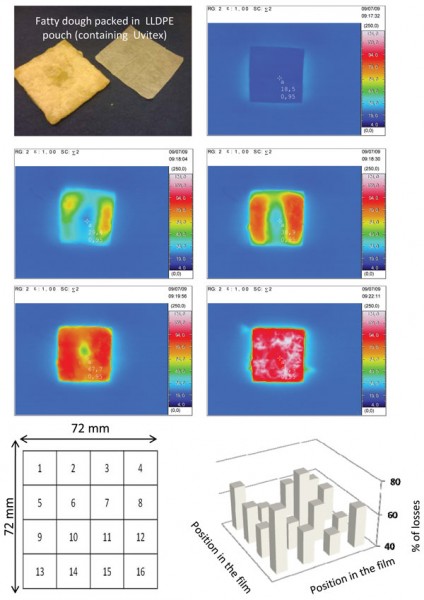

Figure 6 Mapping of the surface temperature of LDPE film used to pack fatty dough during a four minute microwave heating and subsequent predicted migration into food of Uvitex OB initially present in the packaging
References
1. Caner C., Hernandez R.J., Pascall., M.A. (2000) Effect of High-pressure Processing on the Permeance of Selected High-barrier Laminated Films, Pack. Tech. and Sci. 13, 183-195 2. Caner, C., Hernandez, R.J., Harte, B.R. (2004) High-pressure processing effects on the mechanical, barrier and mass transfer properties of food packaging flexible structures: a critical review, Pack. Tech. and Sci. 17, 23–29 3. Yoo S., Lee J., Holloman C., Pascall M.A. (2009) The Effect of High Pressure Processing on the Morphology of Polyethylene Films Tested by Differential Scanning Calorimetry and X-ray Diffraction and Its Influence on the Permeability of the Polymer, J. Appl. Pol. Sci., 112, 107-113. 4. Morris C., Brody A.L., Wicker L. (2007) Non-Thermal Food Processing/Preservation Technologies: A Review with Packaging Implications, Pack. Tech. and Sci. 20, 275-286. 5. Galotto M.J., Ulloa P.A., Hernández D., Fernández-Martín F., Gavara R., Guarda A. (2008) Mechanical and Thermal Behaviour of Flexible Food Packaging Polymeric Films Materials under High Pressure/Temperature Treatments, Pack. Tech. and Sci., 21, 297-308. 6. Di Maio, E., Mali, R., Iannace, S. Investigation of Thermoplasticity of Zein and Kafirin Proteins: Mixing Process and Mechanical Properties, in press in J. Polym. Environ. 7. Zullo, R., Iannace, S., (2009). The effects of different starch sources and plasticizers on film blowing of thermoplastic starch: Correlation among process, elongational properties and macromolecular structure, Carbohydrate Polymers 77, 376–383 8. Oliviero, M., Di Maio, E., Iannace, S., (2010). Effect of Molecular Structure on Film Blowing Ability of Thermoplastic Zein, J. Appl. Polym. Sci., 115, 277–287 9. Badeka, A.B., Kontominas, M.G., 1999. Effect of microwave heating on the migration of dioctyladipate and acetyltributylcitrate plasticizers from food-grade PVC and PVDC/PVC films into olive oil and water. Zeitschrift Fur Lebensmittel-Untersuchung Und-Forschung 202, 313-317. 10. Badeka, A.B., Pappa, K., Kontominas, M.G., 1999. Effect of microwave versus conventional heating on the migration of dioctyl adipate and acetyltributyl citrate plasticizers from food grade PVC and P(VDC/VC) films into fatty foodstuffs. Zeitschrift Fur Lebensmittel-Untersuchung Und-Forschung a-Food Research and Technology 208, 429-433. 11. Begley, T.H., Biles, J.E., Hollifield, H.C., 1991. Migration of an Epoxy Adhesive Compound into a Food-Simulating Liquid and Food from Microwave Susceptor Packaging. Journal of Agricultural and Food Chemistry 39, 1944-1945. 12. Begley, T.H., Dennison, J.L., Hollifield, H.C., 1990. Migration into Food of Polyethylene Terephthalate (Pet) Cyclic Oligomers from Pet Microwave Susceptor Packaging. Food Additives and Contaminants 7, 797-803. 13. Begley, T.H., Hollifield, H.C., 1990a. Evaluation of Polyethylene Terephthalate Cyclic Trimer Migration from Microwave Food-Packaging Using Temperature Time Profiles. Food Additives and Contaminants 7, 339-346. 14. Begley, T.H., Hollifield, H.C., 1990b. High performance liquid chromatographic determination of migrating poly(ethylene terephtalate) oligomers in corn oil. Journal of Agricultural and Food Chemistry 38, 145-148. 15. Begley, T.H., Hollifield, H.C., 1990c. Migration of Dibenzoate Plasticizers and Polyethylene Terephthalate Cyclic Oligomers from Microwave Susceptor Packaging into Food-Simulating Liquids and Food. Journal of Food Protection 53, 1062-1066. 16. Castle, L., Jickells, S.M., Sharman, M., Gramshaw, J.W., Gilbert, J., 1988. Migration of the Plasticizer Acetyltributyl Citrate from Plastic Film into Foods During Microwave Cooking and Other Domestic Use. Journal of Food Protection 51, 916-919. 17. Castle, L., Mayo, A., Crews, C., Gilbert, J., 1989. Migration of Poly(Ethylene-Terephthalate) (Pet) Oligomers from Pet Plastics into Foods During Microwave and Conventional Cooking and into Bottled Beverages. Journal of Food Protection 52, 337-342. 18. Galotto, M.J., Guarda, A., (2004). Suitability of alternative fatty food simulants to study the effect of thermal and microwave heating on overall migration of plastic packaging. Packaging Technology and Science 17, 219-223. 19. Gramshaw, J.W., Soto-Valdez, H., (1998). Migration from polyamide ‘microwave and roasting bags’ into roast chicken. Food Additives and Contaminants 15, 329-335. 20. Hollifield, H.C., (1991). Food and drug administration studies of high-temperature food packaging. In: Risch, S.J., Hotchkiss, J. (Eds.), Food Packaging Interactions II. Oxford University Press. 21. Jickells, S.M., Crews, C., Castle, L., Gilbert, J., (1990). Headspace Analysis of Benzene in Food Contact Materials and Its Migration into Foods from Plastics Cookware. Food Additives and Contaminants 7, 197-205. 22. Jickells, S.M., Gramshaw, J.W., Gilbert, J., Castle, L., (1991). Migration into Food During Microwave and Conventional Oven Heating. Acs Symposium Series 473, 11-21. 23. Johns, S.M., Gramshaw, J.W., Castle, L., Jickells, S.M., (1995). Studies on Functional Barriers to Migration .1. Transfer of Benzophenone from Printed Paperboard to Microwaved Food. Deutsche Lebensmittel-Rundschau 91, 69-73. 24. Johns, S.M., Jickells, S.M., Read, W.A., Castle, L., (2000). Studies on functional barriers to migration. 3. Migration of benzophenone and model ink components from cartonboard to food during frozen storage and microwave heating. Packaging Technology and Science 13, 99-104. 25. Kawamura, Y., Nishi, K., Maehara, T., Yamada, T., (1998). Migration of styrene dimers and trimers from polystyrene containers into instant foods. Journal of the Food Hygienic Society of Japan 39, 390-398. 26. Mitchell, J., (1994). Food Contamination from Microwave Packaging. Search 25, 229-232. 27. Mountfort, K., Kelly, J., Jickells, S.M., Castle, L., (1996). A critical comparison of four test methods for determining overall and specific migration from microwave susceptor packaging. Journal of Food Protection 59, 534-540. 28. Nerin, C., Acosta, D., Rubio, C., (2002). Potential migration release of volatile compounds from plastic containers destined for food use in microwave ovens. Food Additives and Contaminants 19, 594-601. 29. Nerin, C., Fernandez, C., Domeno, C., Salafranca, J., 2003. Determination of potential migrants in polycarbonate containers used for microwave ovens by high-performance liquid chromatography with ultraviolet and fluorescence detection. Journal of Agricultural and Food Chemistry 51, 5647-5653. 30. Risch, S.J., Heikkila, K., Williams, R., (1991). Analysis of volatiles produced in foods and packages during microwave cooking. In: Risch, S.J., Hotchkiss, J. (Eds.), Food and Packaging Interactions II. Oxford University Press. 31. Rose, W.P., (1991). Determining volatile extractives from microwave susceptor food packaging. In: Risch, S.J., Hotchkiss, J. (Eds.), Food Packaging Interactions II. Oxford University Press. 32. Sharman, M., Honeybone, C.A., Jickells, S.M., Castle, L., (1995). Detection of Residues of the Epoxy Adhesive Component Bisphenol-a Diglycidyl Ether (Badge) in Microwave Susceptors and Its Migration into Food. Food Additives and Contaminants 12, 779-787. 33. SotoValdez, H., Gramshaw, J.W., Vandenburg, H.J., (1997). Determination of potential migrants present in Nylon ‘microwave and roasting bags’ and migration into olive oil. Food Additives and Contaminants 14, 309-318. 34. Lambert, Y., Demazeau, G., Largeteau, A., Bouvier, J.M., Laborde-Croubit, S., Cabannes, M., (2000). Packaging for high-pressure treatments in the food industry. Packaging Technology and Science 13, 63-71. 35. Pastorelli, S., 1997. Ital. Imballaggio 9, 98-101. 36. Caner, C., Harte, B., 2005. Effect of high-pressure processing on the migration of antioxidant Irganox 1076 from polypropylene film into a food simulant. Journal of the Science of Food and Agriculture 85, 39-46. 37. Schauwecker, A., Balasubramaniam, V.M., Sadler, G., Pascall, M.A., Adhikari, C., (2002). Influence of high-pressure processing on selected polymeric materials and on the migration of a pressure-transmitting fluid. Packaging Technology and Science 15, 255-262. 38. Mauricio-Iglesias, M., Jansana, S., Peyron, S., Gontard, N., Guillard, V., (2010a). Effect of high-pressure/temperature (HP/T) treatments of in-package food on additive migration from conventional and bio-sourced materials. Food Additives and Contaminants Part a-Chemistry Analysis Control Exposure & Risk Assessment 27, 118-127. 39. Mauricio-Iglesias, M., Peyron, S., Guillard, V., Gontard, N., (2010b). Wheat Gluten Nanocomposite Films as Food-Contact Materials: Migration Tests and Impact of a Novel Food Stabilization Technology (High Pressure). Journal of Applied Polymer Science 116, 2526-2535. 40. Mauricio-Iglesias, M., Guillard, V., Gontard, N., Peyron, S., (2009). Application of FTIR and Raman microspectroscopy to the study of food/packaging interactions. Food Additives and Contaminants Part a-Chemistry Analysis Control Exposure & Risk Assessment 26, 1515-1523. 41. Raouche, S., Mauricio, M., Peyron, S., Guillard, V., Gontard, N., submitted. Antimicrobial activity of bio-sourced material containing Allyl isothiocynanate or Carvacol during HP/T treatments and further storage Food Microbiology.
About the Authors
Stéphane Peyron
Stéphane Peyron is Assistant Professor at the University of Montpellier II in the Biochemistry Department. He is a specialist of vibrational spectroscopy (Infrared and Raman spectroscopies) with a particular focus on their application in mass transfer measurement in food-packaging systems. He has been a participant of the European integrated project NovelQ from 2006 to 2010 on the aspect of safety concerns of food contact materials submitted to the novel food technologies and is author of 15 international publications, 10 communications and book chapters.
Valérie Guillard
Dr. Valérie Guillard is a specialist of mass transfer modelling of food/packaging interactions, working at the University of Montpellier II for 10 years. She is the designer of a mathematical model permitting to predict in advance the mass transfer of gas or vapour in a food / packaging system and between the different phases of a food product (e.g. water migration in composite food). This tool requires an accurate knowledge of the parameters describing mass transfer. Dr. Valérie Guillard is thus working on the determination of diffusivity and solubility parameters in food and packaging materials.
Ernesto Di Maio
Ernesto has been Assistant Professor of Materials Science and Technology since 2004 at the Department of Materials and Production Engineering of the University of Naples Federico II. He has achieved a PhD in Materials Technology in 2001 and, since 2001, has been Visiting Research Scholar in the Department of Chemical Engineering, University of Houston, Houston, Advisor Prof. Raimond W. Flumerfelt. The research work is focused on the thermoplasticisation processes of biopolymers and on their processing technologies such as film blowing and extrusion foaming. The aim is to understand the influence of the processing parameters, composition as well as the molecular architecture on the morphology and properties of the film and foam structures.
Miguel Mauricio
Iglesias Miguel Mauricio-Iglesias holds an MSc in Chemical Engineering from the University of Santiago de Compostela and a PhD in Food Technology from the University of Montpellier II. His research deals with mass transfer in polymers applied to membranes and food packaging. Currently, he is a postdoctoral fellow at the Technical University of Denmark.
Salvatore Iannace
Salvatore Iannace graduated in Chemical Engineering in 1988 at the University of Naples Federico II, where he gained a PhD in 1991. He is the project head of the department of macromolecular design (Italian National Research Council) on ‘Nanostructured, multi component polymeric systems and membranes for functional and structural applications’ from 2007. He is also adjunct professor of Polymer Technologies at the University of Naples Federico II. His principal research activities include biodegradable polymers, composites and nanocomposites, processing and properties of thermoplastic matrix composites, processing and properties of films and foams. He has published over 100 papers on international scientific journals, books and conference proceedings included invited lectures on foams and nanocomposites. He has been the scientific coordinator of approximately 30 national and international research projects. He organised the first conference on Biofoams (2007) and co-chaired the second Biofoams (2009) in Canada, and the foam symposiums at The Polymer Processing Society 24th Annual Meeting (2008).
Giuseppe Mensitieri
Giuseppe Mensitieri graduated in Chemical Engineering on 1985 at the University of Naples Federico II where he is full professor of Materials Science and Technology and of Macromolecular Materials. He is currently Director of the Bachelor Program in ‘Materials Science and Engineering’. His main field of research is that of polymeric materials with focus on structure – properties relationships. In particular, his research activities concern transport through polymers of low molecular weight molecules, thermodynamics of solutepolymer mixtures, polymer – penetrant chemical-physical interactions, technological applications related to mass transport phenomena. Giuseppe Mensitieri has been visiting researcher at the Department of Chemical Engineering of the University of Toronto and the Department of Chemical Engineering of the North Carolina State University. He is author of 85 scientific publications on international refereed journals, eight book chapters and of four patents.
Nathalie Gontard
Nathalie Gontard is a Professor at the University of Montpellier and leader of a team working on an integrated approach of the ‘packaging / food / processing’ systems with a focus on modelling tool, biodegradable, active and nano-engineered materials. She was involved in numerous international (EU and developing countries), national and industrial projects. Currently, she is expert at the EFSA (European Food Safety Authority) and coordinator of the EcoBioCAP EU FP7 project.





